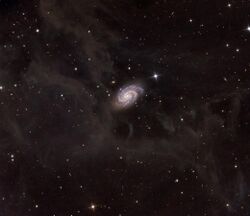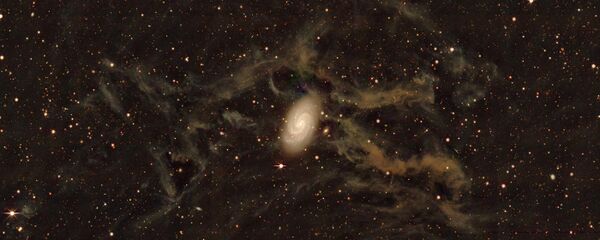Astronomy:NGC 918
| NGC 918 | |
|---|---|
 NGC 918 by the Mount Lemmon SkyCenter | |
| Observation data (J2000 epoch) | |
| Constellation | Aries |
| Right ascension | 02h 25m 50s[1] |
| Declination | +18° 29′ 46″[1] |
| Redshift | 0.005027[2] |
| Helio radial velocity | 1507 ± 3 km/s[2] |
| Distance | 20.6±1.5 mpc [3] |
| Apparent magnitude (V) | 15.01[1] |
| Apparent magnitude (B) | 16.0[1] |
| Characteristics | |
| Type | SAB(rs)c[2] |
| Other designations | |
| NGC 918,MCG+03-07-011, LEDA 9236[1] | |
NGC 918 is a barred spiral galaxy in the constellation Aries, about 67 million light years from the Milky Way. It was discovered by John Herschel on Jan 11, 1831.[4]
The brightness class of NGC 918 is III and it has a broad line of neutral hydrogen. NGC 918 is also an active nucleus galaxy (AGN). Moreover, it is a field galaxy; that is to say, it does not belong to a cluster or group and is therefore gravitationally isolated.[5]
Many non-redshift measures give a distance of 19,115 ± 6,160 Mpc (~62,3 million ly),[6] which is within the distances calculated using the value shift.[3]
Two supernovae have been observed in this galaxy. SN 2009js (type II, mag. 17.2) was discovered on October 11, 2009.[5][7][8][9] This was the first subluminous supernova to be studied in infrared wavelengths.[10] Supernova SN 2011ek (type Ia, mag. 16.4) was discovered on Aug. 4, 2011 by Kōichi Itagaki.[11][12]

References
- ↑ 1.0 1.1 1.2 1.3 1.4 "NGC 918". SIMBAD. Centre de données astronomiques de Strasbourg. http://simbad.u-strasbg.fr/simbad/sim-basic?Ident=NGC+918.
- ↑ 2.0 2.1 2.2 "NASA/IPAC Extragalactic Database". http://ned.ipac.caltech.edu/cgi-bin/objsearch?search_type=Obj_id&objid=6740&objname=22&img_stamp=YES&hconst=73.0&omegam=0.27&omegav=0.73&corr_z=1#BasicData_0.
- ↑ 3.0 3.1 We obtain the distance that separates us from a galaxy using Hubble's law: v = Hod, where Ho is the Hubble constant (70 ± 5 (km / s) / Mpc). The relative uncertainty Δd / d over the distance is equal to the sum of the relative uncertainties of the velocity and Ho.
- ↑ Seligman, Courtney. "New General Catalog Objects: NGC 900 - 949". https://cseligman.com/text/atlas/ngc32a.htm#3294.
- ↑ 5.0 5.1 "Your NED Search Results". http://ned.ipac.caltech.edu/cgi-bin/nph-objsearch?objname=ngc+918&img_stamp=YES.
- ↑ "NED Query Results for NGC 918". https://ned.ipac.caltech.edu/cgi-bin/nDistance?name=NGC+918.
- ↑ "APOD: 2009 November 12 - Art and Science in NGC 918". https://apod.nasa.gov/apod/ap091112.html.
- ↑ SN 2009js at the Crossroads between Normal and Subluminous Type IIP Supernovae: Optical and Mid-infrared Evolution, The Astrophysical Journal, Volume 767, Issue 2, article id. 166, 15 pp. (2013).
- ↑ "Supernova 2009js in NGC 918". https://www.rochesterastronomy.org/sn2009/sn2009js.html.
- ↑ Gandhi, P.; Yamanaka, M.; Tanaka, M.; Nozawa, T.; Kawabata, K. S.; Saviane, I.; Maeda, K.; Moriya, T. J. et al. (2013). "SN 2009js at the Crossroads between Normal and Subluminous Type IIP Supernovae: Optical and Mid-infrared Evolution". The Astrophysical Journal 767 (2): 166. doi:10.1088/0004-637X/767/2/166. Bibcode: 2013ApJ...767..166G. https://ui.adsabs.harvard.edu/abs/2013ApJ...767..166G/abstract.
- ↑ Nakano, S.; Yamaoka, H.; Kadota, K.; Tsuboi, M.; Balam, D. D.; Graham, M. L.; Hsiao, E. Y.; Green, D. W. E. (2011). "Supernova 2011ek near NGC 918 = PSN J02254889+1832000". Central Bureau Electronic Telegrams 2783: 1. Bibcode: 2011CBET.2783....1N. https://ui.adsabs.harvard.edu/abs/2011CBET.2783....1N/abstract.
- ↑ "Supernova 2011ek in NGC 918". https://www.rochesterastronomy.org/sn2011/sn2011ek.html.
External links
- NGC 918 on WikiSky: DSS2, SDSS, GALEX, IRAS, Hydrogen α, X-Ray, Astrophoto, Sky Map, Articles and images
 |

